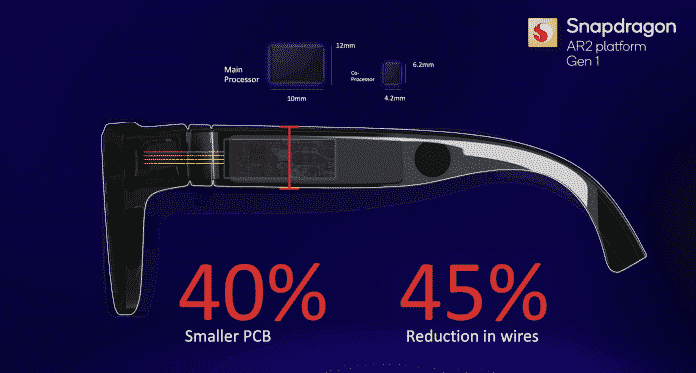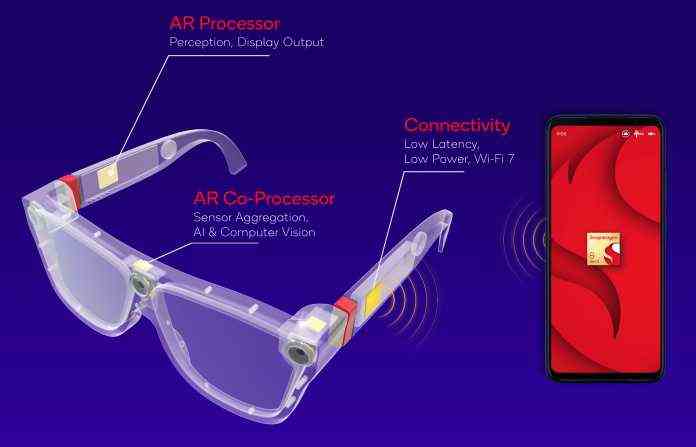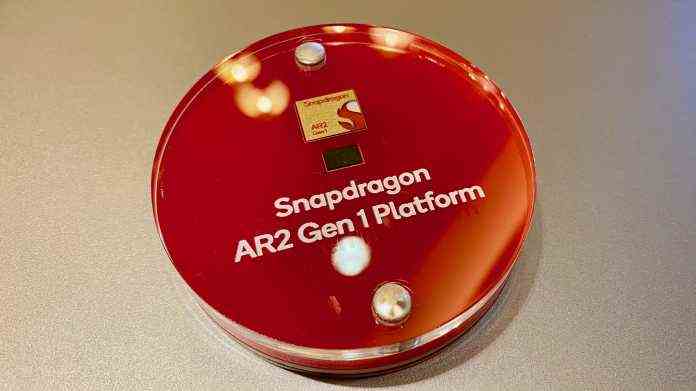With the Snapdragon AR2 Gen 1, Qualcomm has introduced a new processor especially for augmented reality glasses. It is based on a multi-chip design and differs in one important respect from Qualcomm’s previous processors for augmented and virtual reality glasses. Because instead of combining all or at least as many components as possible on one chip, there are now three spatially separate ones. According to Qualcomm, this offers advantages, especially with regard to the design of the glasses.

The new multi-chip design should primarily enable more compact AR glasses due to the lower space requirement.
(Image: Qualcomm)
The brackets of the augmented reality glasses (AR glasses) no longer have to offer space for a large chip, but only a smaller one. The web can also be narrower, since the wiring of the individual components takes up less space due to the multi-chip design and the distributed tasks. Compared to the Snapdragon XR2, which is part of the Meta Quest 2 VR glasses, Qualcomm speaks of a 40 percent smaller chip area and 45 percent fewer cable connections.
Triple processor
In detail, the Snapdragon AR2 Gen 1 consists of three chips. The AR processor is responsible for all operations related to perception and integrated displays. Accordingly, it has its own CPU cores, an image processor (Spectra ISP), a graphics unit and an AI processor (Hexagon). The AR processor is housed – at least according to Qualcomm’s design proposal – in the right temple.
The AR co-processor, on the other hand, sits in the bridge of the glasses above the nose. The sensors and cameras are connected via it. In addition, it has AI and compute vision capacities to evaluate sensor and camera data. Own CPU cores and an AI accelerator are also available here.

Qualcomm distributes the individual components of the Snapdragon AR2 Gen 1 to the temples and the bridge of the AR glasses. The connection to the host is via WLAN.
(Image: Qualcomm)
The third chip sits in the left bracket and is responsible for the connections to the host device. The main component is the FastConnect 7800 communication platform with Wi-Fi 7, which is also used in the Snapdragon 8 Gen 2.

Two of the three components of the Snapdragon AR2 Gen 1: the AR processor at the top, the AR co-processor at the bottom.
Qualcomm does not give details about the CPU and graphics unit. When asked, the company only confirmed that it was not a “smartphone CPU”. The low required computing power and the goal of less than 1 watt of energy consumption are opposed to this.
No host, no augmented reality
A host is required as the Snapdragon AR2 Gen 1 does not have the power to do all the calculations on its own. According to Qualcomm, the host does not necessarily have to be a smartphone, and the company also named PCs as suitable devices. It is crucial that the manufacturer of the AR glasses offers a companion app for the respective platform – such as Android, iOS or Windows. Ideally, the host can handle Wi-Fi 7 due to the high bandwidth and low latency, but the standard is not a must. In the conversation, Qualcomm called Wi-Fi 6E sufficient for smooth data exchange, but Wi-Fi should also offer enough bandwidth and sufficiently low latency.
Compared to the Snapdragon XR2 previously offered for AR glasses, Qualcomm speaks of a 50 percent reduction in energy consumption. At the same time, the AI performance is said to have increased by up to 150 percent in some cases. This applies above all to image processing, including object recognition and the tracking of hand movements.
The first AR glasses based on the Snapdragon AR2 Gen 1 manufactured in 4 nanometers are already being developed by Lenovo, Oppo, Xiaomi and some other manufacturers. However, Qualcomm does not expect availability until the second half of 2023. Software developers can adapt their programs to the Snapdragon AR2 Gen 1 via an SDK. Cooperation with Adobe and Niantic, among others, is intended to simplify the creation of content. Adobe relies on a link to its own programs in order to implement content without programming knowledge.
(pbe)

